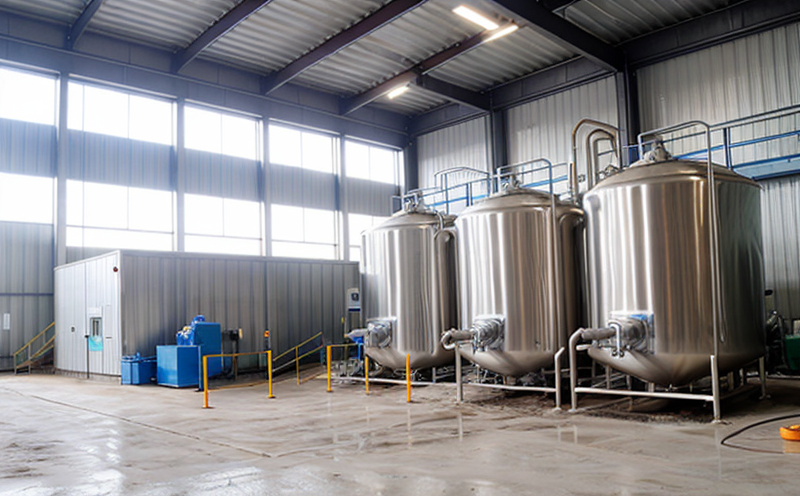ASTM D1067 Alkalinity Test in Industrial Water
The ASTM D1067 standard method is a critical tool used by quality managers, compliance officers, R&D engineers, and procurement teams to ensure the water used in industrial processes meets stringent chemical specifications. This test determines the total alkalinity of water samples, which is essential for controlling pH levels during various manufacturing and processing operations. Total alkalinity refers to the sum of all bases present, such as carbonates, bicarbonates, hydroxides, and other basic compounds that can neutralize acids.
Alkalinity plays a pivotal role in industrial water systems because it impacts several key parameters including pH stability, corrosion control, and process efficiency. For instance, in boiler feedwater, maintaining optimal alkalinity prevents scaling and corrosion of the heat exchanger surfaces. In paper manufacturing, alkalinity helps to reduce acidity generated during cooking processes, ensuring fiber quality.
The ASTM D1067 test protocol involves titrating a water sample with a standardized acid solution until no more color change is observed in the indicator added. The endpoint corresponds to the total amount of bases present in the sample. This method uses phenolphthalein as an indicator for the first endpoint, which signals the presence of bicarbonates and carbonates. For the second endpoint, methyl orange or bromothymol blue can be used if hydroxides are also present.
Industrial water treatment facilities must comply with specific quality standards to ensure product integrity and operational efficiency. By conducting regular ASTM D1067 tests, these facilities can monitor their water supplies for potential issues before they affect downstream processes. This proactive approach not only enhances process performance but also helps in meeting environmental regulations.
Water quality is a complex issue, influenced by numerous factors including source water characteristics, treatment methods employed, and storage conditions. In industrial settings where large volumes of water are used continuously, even small variations in alkalinity can have significant implications for production processes. Therefore, accurate measurement through ASTM D1067 testing ensures consistent product quality and operational safety.
Understanding the role of total alkalinity is crucial not only within individual plants but also across industries sharing common supply networks. Consistent application of ASTM D1067 methods helps maintain uniformity in water quality standards, benefiting all connected entities involved in industrial operations.
Why It Matters
The importance of the ASTM D1067 alkalinity test cannot be overstated for industries reliant on industrial process waters. Alkalinity affects numerous critical aspects of manufacturing and processing including pH control, corrosion prevention, scale inhibition, and chemical reactions involved in product formation.
For instance, in the food and beverage industry, maintaining precise pH levels is essential for flavor development and preservation. An imbalance in alkalinity could lead to off-flavors or spoilage, directly impacting consumer satisfaction and brand reputation. Similarly, in pharmaceutical manufacturing, where purity standards are extremely high, any deviation from specified ranges can compromise product efficacy.
In the chemical industry, proper alkalinity management is vital for ensuring safe handling of reactive materials. Excessive alkalinity might accelerate decomposition rates or cause unwanted side reactions, whereas insufficient levels could result in incomplete neutralization steps during synthesis processes.
Moreover, environmental considerations play a significant role in industrial water usage practices. Many plants are required by law to discharge treated wastewater into natural bodies of water. Ensuring that the discharged effluent meets stringent regulatory limits on alkalinity helps protect aquatic ecosystems and comply with environmental protection acts like the Clean Water Act.
The ASTM D1067 test is a fundamental part of this compliance effort, providing reliable data necessary for determining appropriate treatment methods and discharge regulations. By accurately measuring total alkalinity, industrial facilities can optimize their water management strategies, reducing operational costs while minimizing ecological footprints.
International Acceptance and Recognition
The ASTM D1067 Alkalinity Test enjoys widespread acceptance across various sectors globally due to its reliability and consistency. It is widely recognized as a standard method for determining total alkalinity in water samples, providing a standardized approach that ensures comparability of results worldwide.
International organizations such as the International Organization for Standardization (ISO) often reference ASTM D1067 when developing their own standards related to water quality testing. This cross-referencing underscores the global relevance and utility of this method. Additionally, many countries incorporate ASTM D1067 into national regulations governing industrial processes.
In Europe, EN ISO 8469:2015 on Water for Analytical Purposes specifies the use of ASTM D1067 as part of its requirements for determining total alkalinity in laboratory waters. Similarly, regulatory bodies like the U.S. Environmental Protection Agency (EPA) and various state agencies frequently reference ASTM standards when setting guidelines for industrial water discharge.
The acceptance of ASTM D1067 extends beyond mere compliance; it fosters a culture of best practices among industries committed to sustainable development. By adhering to this internationally accepted standard, organizations demonstrate their commitment to quality assurance and environmental responsibility.
Standardization through ASTM D1067 contributes significantly towards harmonizing global standards for water quality testing. This uniformity benefits both producers who export goods worldwide and consumers who expect consistent performance across different markets.
Use Cases and Application Examples
| Industry Sector | Process Description | Alkalinity Role | ASTM D1067 Impact |
|---|---|---|---|
| Petrochemicals | Refining crude oil into gasoline and other products. | Neutralizing acidic by-products from cracking reactions. | Avoiding acid-induced corrosion in refining equipment. |
| Pharmaceuticals | Synthesis of active pharmaceutical ingredients. | Maintaining neutral pH for chemical stability. | Ensuring consistent product quality and regulatory compliance. |
| Timber Processing | Boiling wood chips to extract lignin. | Controlling acidity to preserve fiber integrity. | Improving papermaking efficiency by preventing degradation. |
| Brewing | Infusing malted grains with hot water for beer production. | Regulating mash pH to enhance flavor profiles. | Achieving consistent taste and aroma in final products. |





